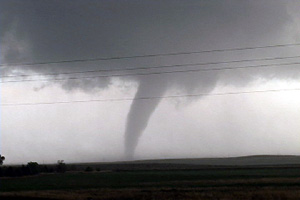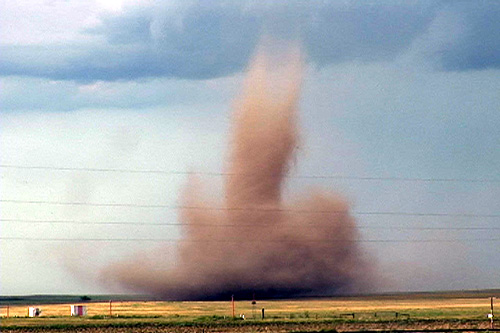What an event!! After watching model run after model run I couldn’t resist the 1700 mile round trip to eastern South Dakota from Denver to chase this one!!! I arrived in Sioux Falls, SD around 3 PM. I couldn’t decide whether to sit tight, head to southern Minnesota or head west towards the advancing front. Each situation had its positives and negatives. After much analysis and some very quick driving, I decided to head west towards the front, which now was firing a string of supercells along it. I targeted the southern supercell coming across the Missouri river north of Pierre. I caught up with it east of Oneida and what a sight it was!!! It took about 10 minutes for it to drop its first of 7 tornadoes that I saw. The structure was second to none as this beautiful striated updraft produced one tornado after another. The largest and strongest tornado developed southwest of Wessington and tracked southeast near Wolsey to southwest of Huron before dissipating. It stayed on the ground over 40 minutes and resembled the Manchester, SD tornado from June 24, 2003 (which I saw from the south side). Finally, the storm produced one last tornado southeast of Huron as it weakened moving towards I-29.
August 20th, 2006 Bennett, Colorado Tornadoes
I wasn’t planning a chase this day. However, as the afternoon progressed an outflow boundary raced south from convection in Wyoming, and intersected the DCVZ boundary that was quite evident running from Bennett to Prospect Valley, Colorado. Good instability, weak shear and the boundary would provide a perfect set up for non-supercell (landspout) tornadoes! And the atmosphere didn’t disappoint! By 5 PM a VERY nice line of towers exploded along the boundary. By 6 PM I had seen 3 funnels. At 6:37 PM the first tornado touched down 4 miles north of my house. It stayed on the ground for 20 minutes before dissipating. The second tornado touched down at 6:54 PM and stayed on the ground for 9 minutes. It was much larger than the first, but outflow from the downdraft of the first cell would kill this tornado much sooner than the first one. At one point in time both were on the ground !
August 30th, 2006 Eastern Colorado Hailstorm
August 30th showed some potential for initially high based convection to get better organized as it moved east off the Palmer Divide into better moisture. That is exactly what it did. Nice upslope flow underneath 30-40 kts mid level westerly flow would provide strong enough shear for storms to become supercellular and produce large hail. Several storms developed on the eastern side of Denver, then most east into a line. However the tail end storm, as is often the case, became a nicely rotating supercell that produced hail to golfball sized. The structure was very nice with HP type characteristics. As the storms approached the Kansas border the dissipated.
August 18th, 2006 Lincoln County, CO Hailstorm
August 18 looked like a fairly marginal day for supercells. However, a deviant moving storm developed south of Limon, CO and moved southwest enhancing its shear to the fullest extent. This storm produced COPIOUS amounts of hail over southeast Lincoln county that destroyed every crop, tree and building in its path. Hail fell for about 40 minutes and ranged in size from quarter to golfball.










